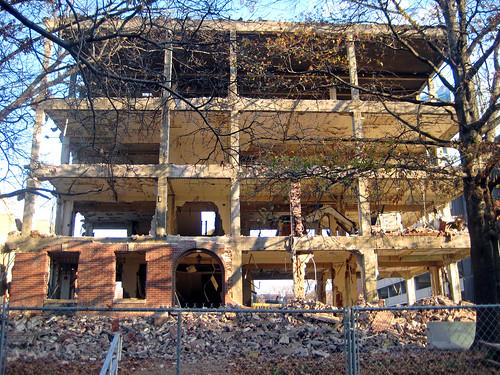 Demolition of the Shoenberg Nurses Residence building at 4949 Forest Park Boulevard has revealed that the building was easily adaptable for new uses. The building's exterior appearance, that of an old heavy brick masonry structure that would be difficult to transform for other uses couldn't be farther from the truth. Beyond the skin deep brick was a solid concrete frame, not unlike that of the also recently demolished San Luis on Lindell Boulevard or that of more recently completed structures such as the 9 North Condominiums, the 4545 Lindell Condominiums, or even the new Centene tower rising in Clayton on the former site of site of Vandervoort's department store.
Demolition of the Shoenberg Nurses Residence building at 4949 Forest Park Boulevard has revealed that the building was easily adaptable for new uses. The building's exterior appearance, that of an old heavy brick masonry structure that would be difficult to transform for other uses couldn't be farther from the truth. Beyond the skin deep brick was a solid concrete frame, not unlike that of the also recently demolished San Luis on Lindell Boulevard or that of more recently completed structures such as the 9 North Condominiums, the 4545 Lindell Condominiums, or even the new Centene tower rising in Clayton on the former site of site of Vandervoort's department store.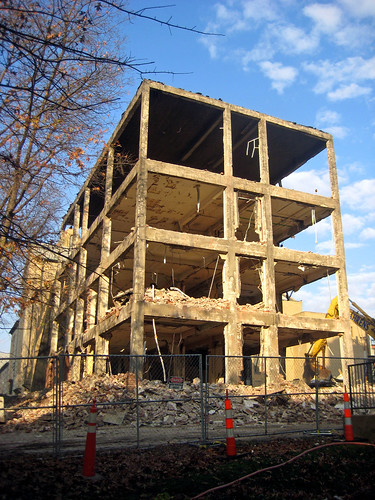 The technology of concrete frame construction surprisingly has changed very little over the years. The concrete frame and slab structure allows for all interior partitions to be completely removed and re-configured for whatever use is desired. This had already occurred at least once in the life of the Shoenberg building. It had been constructed in 1934 as a dormitory structure to house nursing students from the Jewish Hospital School of Nursing nearby on Kingshighway. Its original configuration was likely small rooms double loaded on each side of a central corridor. More recently, the building housed medical clinics, which would have required some reconfiguration of the interior.
The technology of concrete frame construction surprisingly has changed very little over the years. The concrete frame and slab structure allows for all interior partitions to be completely removed and re-configured for whatever use is desired. This had already occurred at least once in the life of the Shoenberg building. It had been constructed in 1934 as a dormitory structure to house nursing students from the Jewish Hospital School of Nursing nearby on Kingshighway. Its original configuration was likely small rooms double loaded on each side of a central corridor. More recently, the building housed medical clinics, which would have required some reconfiguration of the interior. 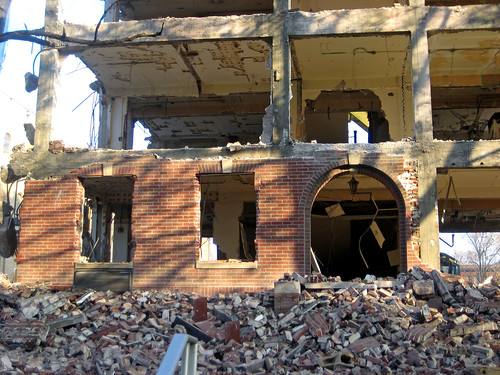 The building could have again been re-configured for new use, but instead, seemingly because they had not use in mind, BJC is knocking down the building and planting some grass. BJC could have simply mothballed the building until a new use was contemplated. Also with its flexible structural system, the building could have even been more than doubled in size per floor with removal of the rear wall and an addition. Eventually, something might be built there, as it is an excellent location with its easy access the adjacent parking structure, but for the foreseeable future the site will remain a pocket park less than 500 feet from one of the largest urban parks in North America.
The building could have again been re-configured for new use, but instead, seemingly because they had not use in mind, BJC is knocking down the building and planting some grass. BJC could have simply mothballed the building until a new use was contemplated. Also with its flexible structural system, the building could have even been more than doubled in size per floor with removal of the rear wall and an addition. Eventually, something might be built there, as it is an excellent location with its easy access the adjacent parking structure, but for the foreseeable future the site will remain a pocket park less than 500 feet from one of the largest urban parks in North America.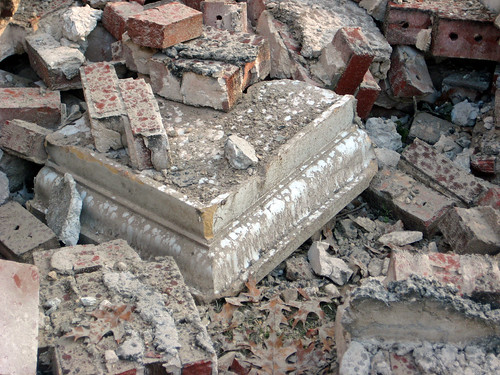 A corner piece of the simple white glazed terra cotta cornice peeks out amid the rubble pile.
A corner piece of the simple white glazed terra cotta cornice peeks out amid the rubble pile.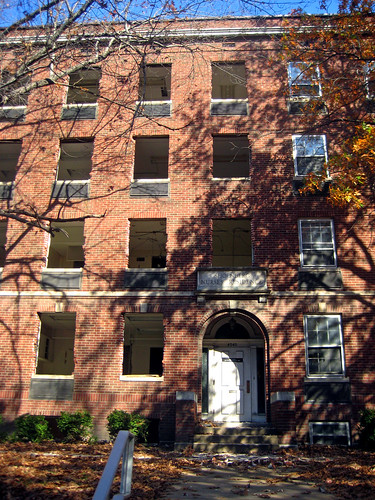
The Shoenberg building a few weeks ago as it was being prepared for destruction.
The wasted opportunities of this building and other recent demolitions such as the San Luis make me think of one of my favorite books: How Buildings Learn by Stewart Brand. One of the main premises of the book is that buildings built with a simple straight forward structure (such as that of a concrete frame) are inherently adaptable to meet the needs of the ever changing world around them. This book should be required reading for all institutional boards of directors and all others that are in the position of decision making regarding construction, renovation, replacement or demolition of their buildings.


5 comments:
UGH. UGH.
I don't know what else to say.
There is such a vacuum in St. Louis in the arena of planning.
It's so hard to celebrate a development like Nine North because, at the same time, a couple block over, we're losing a valuable building to nothingness.
Why the Cultural Resources Office didn't STRONGLY discourage such a demolition is beyond me. That the Preservation Board lacked a nuanced solution is less surprising but no less disappointing in the end.
Sigh.
It's astounding to me that city leaders don't yet seem to know what has contributed to urban revitalization across the nation, but especially right at home. Neighborhoods like Tower Grove South made such an astounding turnaround because these were livable, walkable, human scale (and yes, historic) places.
Ugh. I sound like a broken record. It just sucks to see more CWE character lost for no good reason.
Just, ugh.
This building doesn't fit the Barnes Brand, so it had to come down. Pretty simple, really. Look at most of the recent structures built for the Barnes Brand: nominally modern glass and steel edifices which reference one another. The Shoenberg, even though we all realise its' utility, did not fit into the Brand which Barnes, et al, have so carefully cultivated in the past 10 years. What eventually gets built will look almost like the other recently-built structures. Yeah, and a pocket park is a bit nutty. Is Barnes a not-for-profit? Because if they aren't, they'd have to keep paying taxes on this building, no? Sooo...Just a little ruminatin'.
Shame that all that awesome brick is getting torn down
I love this book. It changed a lot of my thinking about buildings and their adaptability when I first read it years ago. Sadly, I loaned it out to someone who obviously also loved it.
Good work as always.
i noticed that had started while waiting on the yellow bus the other day. UGH.
Matt, the CRO doesn't waste its political capital on useless causes, & fighting BJC is always a such a case. i am not looking forward to having one of their corporate buildings on my side of Forest Park Parkway.
samizdat, BJC is non-profit but their end of year filings usually show an astonishing amount of excess income after paying for charity care, etc.
Post a Comment